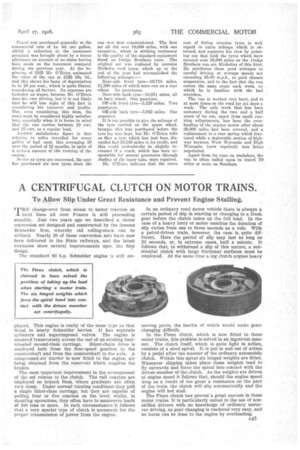THE VALUE OF COSTS TO THE SMALL USER.
Page 28

Page 29

If you've noticed an error in this article please click here to report it so we can fix it.
The Experience of a Leicester User With a Dodge Brothers Van.
FROM what we know through personal contact with small tradesmen running a single motorvan, there must be a large number of users of this class up and down the country who merely rap such a.vehicle because it gives them a Chance of speeding up their delivery system, and, in some instances, of extending their radius of operation.They are sufficiently astute to appreciate the importance of employing a motorvan and -thus keeping abreast of the times and their rivals; but at this point their business instinct fails. If they were asked for details of their costs of working, their answer might be ambiguously wrapped up in the statement that, don't keep costs, but I'm not out of pocket." They care little for the 1.s.d. of transport, and, although they may not be "out of pocket," they might conceivably be more in pocket were they to establish a proper system of costing.
By so doing, many of these users would be given an incentive to reduce costs to the lowest possible level consistent with efficiency, and many would be the directions in which they would find they were able to effect valuable economies.
To those who question the wisdom of this policy we would commend to their notice the experience of Mr. C. R. O'Brien, a boot and shoe factor, of
Leicester and Aylesbury. This user, having had a Dodge Brothers van in use for a period of 18 months, decided, at the opening of the year 1025, that he would like to know what it was costing him to run. He therefore kept an accurate record of his outgoings for the whole of last year, from which he has ascertained that his van costs 8.07d. per mile to run, The van was bought new in 1923, and at the end of 1924 the speedometer recorded a mileage of 16,360, whereas at the end of 1925 the reading was 30,162 miles, thus giving 18,802 miles as the distance travelled during the year. With this figure as a baths, and total costs given at £176 13s. 1d., the cost per mile
figure already given is easily arrived at.-The costs were kept in detail, and are as follow:— s. d.
Petrol 411 16 11 Oil ... 11 0 3
Rent ... 2000 Rates ... 6-17 6 Licence (four quarters at 14 8s.) 17 12 0 Insurance ... 11 14 0 Repairs, Tyres, etc.... 25 2. 5
Depreciation 88 10 0
Petrol was purchased generally at the commercial rate of 1s. 4d. per gallon, whilst a reduction in the insurance premium was brought about by a bonus allowance on account of no claim having been made on the insurance company during the previous year. At the beginning of 1925 Mr. O'Brien estimated the value of the van at £192 10s. Od., and this shows his basis of depreciation to be 20 per cent., which is quite liberal, -considering all factors. No expenses are • included as wages, because Mr. O'Brien does his own driving, but it is not likely that he will lose sight of this fact in considering his turnover and profits. lint, even considering this item, the costs must be considered highly satisfactory, especially when it is borne in mind that the van Carries between 10 cwt. and 15 cwt, as a regular load.
Another satisfactory figure is that relating to miles travelled for every gallon of fuel used, this averaging 20 over the period of 12 months, in spite of R certain amount of idle running of the -engine.
So far as tyres are concerned, the user has purchased six new tyres since the
van was first commissioned. The first set all did over 10,000 miles, with one exception, which is striking testimony to the quality of the standard equipment fitted on Dodge Brothers vans. The original set was replaced by oversize Michelin cord tyres, which up to the end of the year had accomplished the following mileages:
Near-side front tyre-16,710 miles, 11,300 miles of which were run on a rear wheel. No punctures.
Near-side back tyre-10,871 miles, all on back wheel. One puncture.
Off-side front tyre-5,129 miles. Two punctures.
Off-side back tyre-3,942 miles. One puncture.
It is not possible to give the mileage of the tyre carried on the spare wheel, because this was purchased before the tyre log was kept, but Mr. O'Brien tells us that a tyre which has just been discarded had 16,2143 miles to its credit, and this could undoubtedly be slightly increased if a crack, which has been responsible for several punctures through chafing of the inner tube, were repaired.
Mr. O'Brien believes that the extra cost of fitting oversize tyres is well repaid in extra mileage which is obtained, and supports his view by pointing out that both the tyres which have covered over 16,000 miles on the Dodge Brothers van are Michelins of this kind. He attributes these good mileages to careful driving at average speeds not exceeding 25-30 m.p.h., to good chassis suspension, and to the fact that the van covers the same route each week, on . which he is familiar with the bad stretches. •
The van is worked very hard, and is at most times on the road for six days a week. The only work that has been necessary during the two and a half years of its use, apart from small running adjustments, has been the overhauling of the starter motor after about 29,000 miles had been covered, and a replacement to a rear spring which fractured while a deplorable section of highway between West Wycombe and High Wycombe (now repaired) was being negotiated.
Apart from its runs on weekdays, the van is often called upon to travel 70 miles or more on Sundays.
































